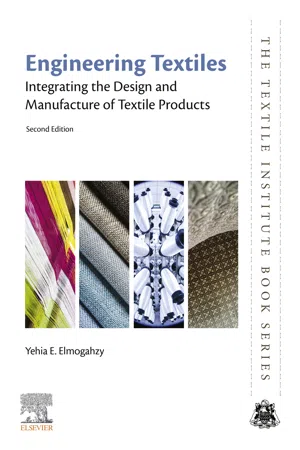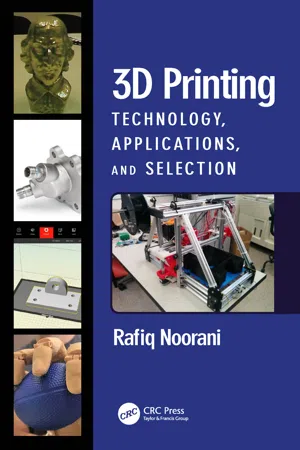Technology & Engineering
Types of Materials
Materials can be classified into various types based on their properties and composition. Common types of materials include metals, polymers, ceramics, and composites. Each type has distinct characteristics that make them suitable for specific applications in engineering and technology. Understanding the properties of different materials is essential for selecting the most appropriate material for a given purpose.
Written by Perlego with AI-assistance
Related key terms
Related key terms
1 of 4
Related key terms
1 of 3
7 Key excerpts on "Types of Materials"
- eBook - ePub
Process Planning
The Design/Manufacture Interface
- Peter Scallan(Author)
- 2003(Publication Date)
- Butterworth-Heinemann(Publisher)
et al. , 1999). These will also be considered further, albeit briefly.Figure 4.1 General classification of materials for manufacture4.4 Basic material properties
Regardless of the type of material, all materials will exhibit specific characteristics and properties during processing and in use. These characteristics and properties are heavily influenced by the atomic structure of the material. However, the consideration of material structures is outside the scope of this text and readers are advised to check the references at the end of this chapter for further reading. This section will focus solely on the characteristics and properties of materials.Regarding description of materials in terms of their properties, there are two distinct property sets to be considered. The first of these are the mechanical properties, which describe how a material reacts under applied loads. The other set is the physical properties of the material such as density and melting point. The major mechanical and physical properties to be considered are illustrated in Fig. 4.2 .Figure 4.2 General mechanical and physical material properties4.4.1 Mechanical properties
The intention of this section is to briefly describe the main mechanical properties of materials for manufacture. It is not to provide detailed coverage of these properties as some previous knowledge is assumed. Again, for detailed coverage, refer to the reference list at the end of the chapter.Strength
The strength of a material is measured in three ways. The first of these is the tensile strength. This is the strength of a material when two loads pull it apart and is calculated by dividing the force applied by the cross-sectional area of the material. Thus, tensile strength is measured in newtons per square metre (N m−2 ). Compressive strength is equally important and measures its resistance to squeezing forces without cracking. Finally, there is shear strength, which measures a material’s ability to withstand forces acting perpendicular to the main axis of the part and which can cause failure across the cross-sectional area. This is also measured in newtons per square metre (N m−2 - Alting(Author)
- 2020(Publication Date)
- CRC Press(Publisher)
In forming from the liquid material state, the final material properties depend mainly on the composition (including solidification temperature range), the thermal and mechanical properties of the molding or die material, and the solidification conditions (direction, rate, etc.). In forming from the solid material state by plastic deformation, the amount of deformation, the temperature, and the rate of deformation primarily determine the final properties. Cold deformation increases the strength and decreases the ductility of the material. Hot deformation gives poor surface quality and reasonably good mechanical properties. Solid-state forming by machining (mass-reducing processes) primarily influences the surface properties (roughness, hardness, internal stresses, etc.). The examples mentioned only serve to illustrate the complexity of the evaluation of the final material properties of a component. These problems are discussed in more detail in some of the later chapters.3.4 CLASSIFICATION OF MATERIALS
As mentioned previously, it is very difficult to provide broad information regarding all the important engineering materials in this context. Consequently, only a general survey will be given to allow a rough evaluation of the suitability of the different material groups for various processes. From this survey and the process descriptions in the later chapters, a reasonable background for the evaluation of the final properties of the materials will be available.Engineering materials can be divided into groups showing important relationships. In this context the traditional classification shown in Fig. 3.1 will be followed.The main groups are metallic materials, nonmetallic materials, and composite materials. Composite materials are built up from two or more materials, so that new and special properties are obtained. Metallic materials are subdivided into ferrous and nonferrous metals. The nonmetallic materials are subdivided into polymers, ceramics, and glasses, but the group covers many other materials (wood, concrete, bricks, etc.) that are not important for the present discussion.FIGURE 3.1 Classification of some of the engineering materials.3.5 METALLIC MATERIALS
3.5.1 Bonding and Structure
Metals are characterized by the metallic bonding , where the metal ions are held together by an “electron cloud.” This type of bonding has a high mobility of the free (valence) electrons and accounts in general for the high strength level, the ductility (ability to be deformed without fracture), and the relatively high melting temperature of metals. These general tendencies can be influenced by many factors; consequently, exceptions are common.Metals have a crystalline structure with predominantly body-centered cubic, face-centered cubic, or close-packed hexagonal lattice structures. Crystalline materials normally consist of thousands of small individual crystals or grains, depending on the production method. During solidification, many individual lattices begin to form at various points within the melt. As solidification proceeds these crystals or grains, which have random orientation, grow, meet, and form the grain boundaries (Fig. 3.2- eBook - ePub
- Julian Happian-Smith(Author)
- 2001(Publication Date)
- Butterworth-Heinemann(Publisher)
2Modern materials and their incorporation into vehicle design
Rob Hutchinson, BSc, MSc, MRIC, CChem, MIM, CEngThe aim of this chapter is to:• Introduce the broad range of materials that designers can draw upon;• Introduce the properties of materials that are required for vehicle design;• Demonstrate particular uses of material properties by case studies;• Demonstrate the material selection process and its interactivity with design.2.1 Introduction
The main theme of this chapter will be the study of the various inter-relationships between the structure of engineering materials, the methods of component manufacture and their ultimate designed behaviour in service. The four major groups of engineering materials are metals and alloys; ceramics and glasses; plastics and polymers and modern composites, such as silicon carbide reinforced aluminium alloys. Illustrative case studies will make up a significant section of this chapter.The full range of these engineering materials is used in the construction of motor vehicles. It is a common myth that the aerospace, defence and nuclear industries lead the way in the use of materials for aggressive environments and loading regimes. The automotive industry has its own agenda with the added criteria of consumer demands of acceptable costs as well as critical environmental issues. Engineers, in general, are familiar with metals since they have the all-round properties, which are required for load bearing and other applications. This situation is helped economically by the fact that of the hundred or so elements within the earth’s crust, the majority are metals. This means that whilst some are more difficult to extract than others, a wide range of metals is available to supplement iron, aluminium, copper and their wide-ranging alloys. Metals have adequate strength, stiffness and ductility under both static and dynamic conditions. Other physical properties are also acceptable such as fracture toughness, density, expansion coefficient, electrical conductivity and corrosion and environmental stability. A wide range of forming and manufacturing processes have been developed as well as an extensive database of design properties (Timmings and May, 1990 - eBook - ePub
Engineering Textiles
Integrating the Design and Manufacture of Textile Products
- Yehia Elmogahzy(Author)
- 2019(Publication Date)
- Woodhead Publishing(Publisher)
7Material selection
Abstract
Material selection represents the most critical aspect of design engineering. Understanding material structure, properties, and processing represents a common knowledge base between scientists, engineers, and technologists. Many design problems are solved either by selecting raw materials of better attributes or by changing the type of material used. The fact that material can be stiff, strong, ductile, brittle, tough, or hard provides numerous design options that are suitable for a wide range of end products. Since raw material makes up the building blocks of all manufacturing processes, the choice of one raw material versus another could mean substantial cost reduction. This point is very common in textile technology in which manufacturing cost is often minimized by the choice of an appropriate fiber type or blending fibers of different prices at predetermined ratios and under quality constraints. In this chapter, basic steps of material selection in design applications are discussed. The key tasks of evaluating material candidates for a certain product are reviewed. These include (a) knowledge of the common material categories (i.e., screening category), (b) understanding basic material properties (i.e., screening property), (c) determining the optimum cost of material with respect to its performance and its contribution to the value of the end product, (d) understanding the effects of technology on material selection, and (e) understanding the differences between design-direct and value-impact performance characteristics. Many examples of fibrous materials are presented in the context of these tasks. - eBook - ePub
The ELSI Handbook of Nanotechnology
Risk, Safety, ELSI and Commercialization
- Chaudhery Mustansar Hussain, Chaudhery Mustansar Hussain(Authors)
- 2020(Publication Date)
- Wiley-Scrivener(Publisher)
The problem of classification of new materials is currently being studied by different disciplines (materials science, engineering and architecture in primis), each tending to organize its part in relation to some characterizing aspects:- The typical classification of materials science is linked to the understanding of internal structures of matter and is based on its chemical composition, for knowing its processability at atomic and molecular level, and its specific properties (density, electrical conductivity, etc.);
- In the engineering field, the classification is oriented to the definition of the possible applications of every single material, and relates the chemical-physical origin (organic, inorganic materials, alloys, ferrous materials, non-metals, composites, etc.) with performance (intrinsic and extrinsic) and production methods (molding, rolling, extrusion, etc.);
- In the architectural field, the classification is strongly linked to the normative and performance aspects that determine the possible applications of materials (seen therefore as “industrial products”), in relation to the compliance with the standard requirements for buildings. The subdivision of building system identifies where a given material is used, by distinguishing, for example, the supporting structure from infills. Consequently, the characteristics of materials are specified in relation to their made use (as the distinction of types of wood used in structures or in windows).
In other words, the materials science classification explains “why” a material is different from another one, the engineering classification determines “how” a material behaves, the architecture classification indicates “what” a material can be and “where” it is used [9 , 20 - eBook - ePub
Engineering Textiles
Integrating the Design and Manufacture of Textile Products
- Y El Mogahzy(Author)
- 2008(Publication Date)
- Woodhead Publishing(Publisher)
20 The popularity of semiconductors stems from the fact that they represent key elements in the majority of electronic systems, serving communications, signal processing, computing and control applications in both consumer and industrial markets. The study of semiconductor materials began in the early 19th century. Elemental semiconductors are those composed of a single species of atoms, such as silicon (Si), germanium (Ge) and tin (Sn) in group IV and selenium (Se) and tellurium (Te) in group VI of the Periodic Table. There are, however, numerous compound semiconductors, which are composed of two or more elements.Ceramics are as old as the human race. It is a unique class of inorganic, non-metallic materials that exhibit many useful properties such as high strength and hardness, high melting temperatures, chemical inertness, and low thermal and electrical conductivity. Ceramics are also brittle and sensitive to flaws and crack propagation. They are typically categorized with respect to the type of product made from them. In this regard, there are two product categories:20 traditional and advanced ceramics. Traditional ceramic products are made from common, naturally occurring minerals such as clay and sand. Advanced ceramics are often produced under specific conditions to serve intended functions or yield performance products ranging from common floor tiles to nuclear fuel pellets.The revolutionary expansion of material applications and the continuous development of new materials have altered the world. Today, material type and material characteristics represent the major aspect of any engineering application. Many engineers categorize materials not by the classic categories discussed above but rather by their functional performance. Table 2.2 provides a list of categories of some of the functional materials available today.Table 2.2Examples of material categories and their definitions2 , 9 , 16 ,20Material system Definition Fibrous material A fiber-based material; mostly anisotropic (but can be isotropic), light weight and flexible Composite A mixture or combination of two or more macro-constituents that differ in form or material composition and are essentially insoluble in each other. A composite derivative is fiber composite, which is a material in which a fibrous phase that retains its physical identity is dispersed in a continuous matrix phase - eBook - ePub
3D Printing
Technology, Applications, and Selection
- Rafiq Noorani(Author)
- 2017(Publication Date)
- CRC Press(Publisher)
5Materials for 3D Printing
5.1 Introduction
Materials are the building blocks of 3D printers. The type of material directly affects the shape, dimensions, durability, and applications. In industry, all products are manufactured from one or multiple materials. For example, an automobile contains a wide variety of materials, such as steel for gears, glass for windows, plastic for dashboards, and rubber for tires. However, in 3D printing (3DP), there are not many materials available and the selection of materials is limited. The next generation of 3D printers should have improved processing methods so that a wider variety of materials with “intrinsic material” properties can be produced. Figure 5.1 shows a wheel prototyped for an automobile [1 ].This chapter discusses the different Types of Materials currently being used in 3D printers. In general, there are three main categories of materials used in 3DP; they are liquid-based materials, solid-based materials, and powder-based materials. Each of these three categories has different Types of Materials such as polymers, metals, ceramics, and composites. These four Types of Materials will be covered in Section 5.2 . The liquid-based, solid-based, and powder-based materials will be discussed in Sections 5.3 , 5.4 , and 5.5 , respectively [2 ,3 ].FIGURE 5.1 A car wheel is prototyped using additive manufacturing.5.2 Types of Materials
This section describes the characteristics of polymers, metals, ceramics, and composites, which are the four main Types of Materials used in 3DP. More discussion will be devoted to polymers as more 3DP development has occurred in these materials. All of these materials will be discussed in terms of properties, advantages and disadvantages, and applications. Materials combination falls into any of the three categories, whether they may be metal polymers, ceramic polymers, or ceramic/metal composites. The three basic material types and their composites are shown in Figure 5.2
Index pages curate the most relevant extracts from our library of academic textbooks. They’ve been created using an in-house natural language model (NLM), each adding context and meaning to key research topics.
Explore more topic indexes
Explore more topic indexes
1 of 6
Explore more topic indexes
1 of 4






